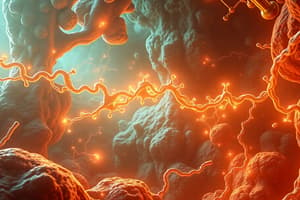Podcast
Questions and Answers
What is one of the primary functions of the pentose phosphate pathway?
What is one of the primary functions of the pentose phosphate pathway?
- Conversion of pyruvate to lactate
- Production of ATP
- Synthesis of glycogen
- Formation of NADPH (correct)
The pentose phosphate pathway occurs in the mitochondria of cells.
The pentose phosphate pathway occurs in the mitochondria of cells.
False (B)
Name three tissues that have active pentose phosphate pathways.
Name three tissues that have active pentose phosphate pathways.
Liver, adipose tissue, erythrocytes
Transketolase transfers __________ carbon groups from a ketose to an aldose.
Transketolase transfers __________ carbon groups from a ketose to an aldose.
Which enzyme requires TPP as a co-factor for its function?
Which enzyme requires TPP as a co-factor for its function?
The non-oxidative phase of the pentose phosphate pathway is responsible for producing ribose precursors.
The non-oxidative phase of the pentose phosphate pathway is responsible for producing ribose precursors.
What is the end product of the oxidative phase of the pentose phosphate pathway?
What is the end product of the oxidative phase of the pentose phosphate pathway?
Match the following substances with their roles in the pentose phosphate pathway:
Match the following substances with their roles in the pentose phosphate pathway:
What is the primary function of glucose-6-phosphate dehydrogenase in the pentose phosphate pathway?
What is the primary function of glucose-6-phosphate dehydrogenase in the pentose phosphate pathway?
Glucose-6-phosphate dehydrogenase is primarily regulated by __________ feedback inhibition by NADPH.
Glucose-6-phosphate dehydrogenase is primarily regulated by __________ feedback inhibition by NADPH.
The accumulation of hydrogen peroxide in erythrocytes can extend their life span.
The accumulation of hydrogen peroxide in erythrocytes can extend their life span.
What tripeptide is composed of g-glutamate, cysteine, and glycine?
What tripeptide is composed of g-glutamate, cysteine, and glycine?
Match the following compounds with their roles:
Match the following compounds with their roles:
What condition can be induced by anti-malarial drugs in susceptible G6PD-deficient individuals?
What condition can be induced by anti-malarial drugs in susceptible G6PD-deficient individuals?
The gene for glucose-6-phosphate dehydrogenase is located on the Y chromosome.
The gene for glucose-6-phosphate dehydrogenase is located on the Y chromosome.
How many people worldwide are estimated to carry a mutated gene for glucose-6-phosphate dehydrogenase?
How many people worldwide are estimated to carry a mutated gene for glucose-6-phosphate dehydrogenase?
Study Notes
Pentose Phosphate Pathway (PPP)
- The pentose phosphate pathway, also known as the hexose monophosphate shunt, is an alternative route for glucose metabolism.
- The PPP plays two significant roles:
- NADPH Production: It generates NADPH, essential for:
- Fatty acid and steroid synthesis
- Maintaining reduced glutathione for antioxidant activity, particularly in red blood cells (RBCs) to prevent hemolysis
- Ribose Synthesis: It synthesizes ribose, required for nucleic acid formation.
- NADPH Production: It generates NADPH, essential for:
- Three molecules of glucose-6-phosphate (G6P) are converted into:
- Three molecules of carbon dioxide (CO2)
- Three 5-carbon sugars rearranged to regenerate two molecules of G6P and one molecule of glyceraldehyde-3-phosphate.
- G6P can be recycled back into the pathway, leading to further NADPH production.
- Tissues with active PPP include:
- Liver
- Adipose tissue
- Adrenal cortex
- Testis
- Lactating mammary gland
- Erythrocytes
Reactions of the Pentose Phosphate Pathway
- Occur in the cytosol.
- Divided into two phases:
- Irreversible Oxidative Phase:
- G6P undergoes dehydrogenation and decarboxylation, resulting in the production of a pentose, ribulose-5-phosphate.
- Reversible Nonoxidative Phase:
- Ribulose-5-phosphate is converted back to G6P through a series of reactions involving key enzymes: transketolase and transaldolase.
- Irreversible Oxidative Phase:
Transketolase
- Transfers 2-carbon groups from a ketose to an aldose.
- This process converts the ketose (donor) into an aldose and the aldose (acceptor) into a ketose.
- Requires thiamine pyrophosphate (TPP) as a cofactor for the transfer reaction.
Transaldolase
- Transfers 3-carbon groups in a similar manner to transketolase.
- Both transketolase and transaldolase catalyze reversible reactions.
The Oxidative Phase: Generating NADPH
- This phase produces NADPH.
The Non-Oxidative Phase: Generating Ribose Precursors
- This phase generates precursors for ribose synthesis.
Ribose Synthesis
- Ribose can be synthesized in almost all tissues.
- A fully functional PPP isn't necessary for ribose-5-phosphate synthesis in all tissues.
- Many tissues (e.g., muscle) can synthesize ribose-5-phosphate by reversing the nonoxidative phase of the PPP using fructose-6-phosphate.
Regulation of the Pentose Phosphate Pathway
- Glucose-6-Phosphate Dehydrogenase:
- The first step in the PPP and rate-limiting enzyme.
- Allosteric Regulation:
- The pathway is feedback-inhibited by NADPH.
- Inducible Enzyme:
- The pathway is induced by insulin.
Pentose Phosphate Pathway and Glutathione Peroxidase in Red Blood Cell Protection
- Glutathione:
- Glutathione (GSH) is a tripeptide composed of γ-glutamate, cysteine, and glycine.
- The -SH groups of two glutathione molecules form a disulfide bond (GS-SG) when oxidized by various oxides and peroxides in cells.
- Glutathione reductase reduces GSSG back to two moles of GSH, requiring NADPH as a reducing agent.
- Red Blood Cells (RBCs):
- The PPP is the only source of NADPH in RBCs, crucial for reducing oxidized glutathione.
- This reaction is critical because accumulation of hydrogen peroxide (H2O2) can shorten erythrocyte lifespan by causing oxidative damage to the cell membrane, leading to hemolysis.
Clinical Aspects: Impairment of the Pentose Phosphate Pathway
- Erythrocyte Hemolysis:
- Deficiency in the PPP can lead to erythrocyte hemolysis.
- Genetic defects in glucose-6-phosphate dehydrogenase (G6PD), impairing NADPH generation, are common in Mediterranean and Afro-Caribbean populations.
- The G6PD gene is located on the X chromosome, making males more susceptible to the disorder.
- Over 400 million people carry a mutated G6PD gene (the most common genetic defect), but most are asymptomatic.
G6PD Deficiency
- Hemolytic Anemia:
- Individuals with G6PD deficiency are at risk of developing hemolytic anemia when exposed to oxidative stress.
- Exposure to antimalarial drugs like primaquine can increase cellular production of superoxide and hydrogen peroxide, leading to a condition called primaquine sensitivity.
- Other Oxidant Stress-Inducing Chemicals:
- Sulfonamides (antibiotics)
- Aspirin and NSAIDs
- Quinidine and quinine
- Fava beans (favism)
Studying That Suits You
Use AI to generate personalized quizzes and flashcards to suit your learning preferences.
Related Documents
Description
This quiz covers the Pentose Phosphate Pathway (PPP), highlighting its crucial roles in NADPH production and ribose synthesis. Understand the metabolic processes involved, including the conversion of glucose-6-phosphate and the tissues where the PPP is active. Test your knowledge on this essential metabolic pathway!




